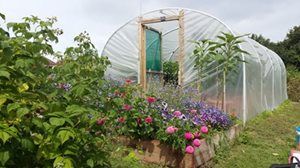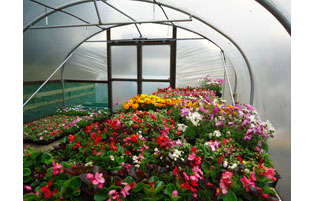Bees are crucial for gardeners. This is because they are pollinators, and pollination is needed for plants to reproduce. Therefore, to promote healthy crops that return season after season, gardeners aim to encourage bees into their allotments and onto their vegetable patches.
Whether you’re new to gardening or you’ve been growing crops for a while, it’s important to fully understand why pollination is important and how it works. If you have been trying to entice pollinators into your polytunnel for a while but you have always wondered how bees pollinate plants, read on.
How do bees pollinate plants?
How many flowering plants are growing inside your polytunnel? It’s important to ensure you have lots of plants that include flowers as part of their life cycle because the flower is the part of the plant that bees are attracted to. Within the flower there is nectar and pollen which the bee collects.
Pollen from one flower’s stamen – the male part of a flower – sticks to the bee’s hairs. As the bee moves from one flower to the next, some of this pollen is transferred to the stigma, which is the female reproductive organ of the flower.
What happens to your plants when pollinated
When the pollen has been moved to the stigma, fertilisation of your plants is able to take place. This produces fruit that contains seeds – and new seeds means new plants. As you are growing your crops inside a polytunnel, the dispersal of these seeds is likely to be more contained than if the seeds were present in an exposed allotment or vegetable patch.
You can also easily take the seeds from the fruit and plant them in a designated part of your polytunnel, meaning you are able to plan ahead to the next lot of crops.
So, this pollination process makes bees integral to growing and harvesting fruit and veg.
 How to encourage pollination
How to encourage pollination
As pollination is so important to the future of the fruit and vegetables in your polytunnel, you can start to plot out the flowering plants that will attract bees. While your focus will be on crop-producing plants, setting aside some corners of your polytunnel for some flowers is a worthwhile addition to your polytunnel layout.
Here are some of the features on flowers that draw bees in:
Vibrant petals
Large, colourful petals will be noticed by a bee. A series of flowers featuring these are more likely to make an impact, so placing some together in several clusters around your polytunnel increases your chances of the bees pollinating your crops en route to the next bright flower.
Attractive scent
A strongly-scented, nectar-rich flower will also entice bees into your garden. Nectar is one of the main things that bees want from a flower, and the scent of a flower will direct bees to its source.
Pollen grains
Once the bee reaches the flower, it is efficient at picking up any pollen that is present. However, the more pollen there is, the better your chances of the bee pollinating your crops.
What to plant
If you’re trying to plan out the flowers you want to incorporate into your polytunnel, there are a few that you can start with:
 Colourful florals
Colourful florals
Bees can see purple and blue flowers best, so these are the colours to aim for when adding flowers to your polytunnel. Lavender, catmint and alliums are a great starting point.
The shape of things
Tubular-shaped flowers are favoured by the bumblebee in particular. Add some purple foxgloves or honeysuckle and you will soon see bees fly your way.
Year-round flowers
While spring and summer are the seasons when bees are most likely to come out of the hive, certain bees do make an appearance on warmer autumn and winter days. Keeping some flowers in your polytunnel that are rich in nectar and pollen throughout the cooler seasons will cater for these industrious bees and could give your overwinter crops a helping hand.
Consider the layout
Planning the layout of your polytunnel in detail will give you the opportunity to strategically place your bee-attracting flowers close to the crops you hope to pollinate. As the warmer months approach, now is the time to start rethinking the set-up. To find out more about polytunnel layouts, see our guide.